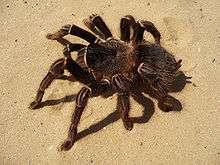Lasiodora parahybana
| Brazilian salmon pink bird-eating tarantula | |
|---|---|
 | |
| Scientific classification | |
| Kingdom: | Animalia |
| Phylum: | Arthropoda |
| Class: | Arachnida |
| Order: | Araneae |
| Suborder: | Mygalomorphae |
| Family: | Theraphosidae |
| Genus: | Lasiodora |
| Species: | L. parahybana |
| Binomial name | |
| Lasiodora parahybana (Mello-Leitão, 1917) | |
Lasiodora parahybana, the Brazilian salmon pink bird-eating tarantula, also simply known as the salmon pink or LP, is a relatively large tarantula from north-eastern Brazil. L. parahybana is considered to be the third largest tarantula in the world (behind Theraphosa blondi and Theraphosa apophysis; however, the largest spider is the giant huntsman spider in terms of leg-span).
It was discovered and described in 1917 by Cândido Firmino de Mello-Leitão, in Paraíba, where the tarantula is endemic.[1] They are popular pets in the tarantula hobby due to their large size and readiness to breed.
Description
The salmon pink bird-eater can attain a leg size of up to 11 inches; especially in males as their legs are longer than the female’s. However, females can weigh more than 100 grams.[2] Females are often ‘bulky;’ they have a large body size in comparison to their legs. Males tend to be slender in body size. This is sexual dimorphism. Mature males will also have tibial hooks on the front pair of legs; these hook back a female’s fangs during mating.
They are considered a ‘pretty’ tarantula species; they are a uniform black colour, and once mature, have pink-red hairs along the legs, chelicerae and abdomen; in males, the colour tends to be more vibrant. Black or brown hair covers the rest of the tarantula.
L. parahybana are endemic to Brazil in the Atlantic forest region of the country; they are known from one area near Campina Grande.[2]
Behaviour
When threatened, the tarantula will raise its legs in the air, as well as the front of its body, in order to deter predators. If the attacker continues to attack, the tarantula will bite. The Brazilian salmon pink tarantula is capable of delivering a painful bite. They are known to bite only when provoked, and even then, this is a last resort. Bites from an L. parahybana are mechanically dangerous; fangs can be up to an inch long. Some sites claim that a bite from a salmon pink is similar to that of a cat.[3] However, rather than biting, they choose to flick urticating hairs from a patch on their abdomen; these hairs are covered in barbs which irritate the skin and put off potential predators. These hairs are extremely irritating; in the hobby, they are considered to be one of the more painful hair types. If the hairs are thrown into the eyes, blindness can occur.
In the wild, a salmon pink will feed mainly on large insects, and occasionally amphibians and small reptiles. Although they are known as a bird-eating spider, there is very little evidence to suggest they actually catch and eat birds. They do not spin webs to catch prey; instead, they will lie in wait and strike prey as it passes by. As an ambush predator, they will quickly inject venom into prey to subdue it.[2]
In the wild, the tarantula will inhabit the forest floor, where it will take up residence in hiding places such as leaf-litter, inside logs, or in burrows or out in the open.
Due to their exoskeleton and method of growth, salmon pinks will regularly moult out of their old skin; this is known as ecdysis. Like most tarantulas, they will lie on their back and force themselves out of their old skin. During this time, they are at risk of predation. A tarantula will stop eating a few days before this process.
Breeding
During the breeding season, males will deposit sperm from their abdomen onto a webbed mat, also known as a sperm web. They will then “soak” up the sperm with its pedipalps and find a female. When a female is located, the two trade signals in order to establish species, and to discover if the female is receptive. The male will push a female back with his front two legs, using the tibial hooks to push the fangs back in order to prevent being over-powered and eaten by the female. He will then insert his pedipalp into the epigastric furrow on the female’s abdomen and empties his pedipalp. He repeats this with the other pedipalp.[4][5]
Once mating is over, the male will unhook his front legs from the female and run. Females have a tendency to give chase for a short while; males who are too slow are at risk of being eaten in order to sustain the future embryos.
In captivity
Brazilian salmon pink tarantulas are very popular in captivity; this is for a number of reasons. Their appearance, both in size and color, makes them desirable. Their willingness to sit out in the open also makes them popular. They are also a cheaper option than a T. blondi; L. parahybana reproduces in large numbers to the point that the price of spiderlings drops dramatically.[4]
Another point is their ease of handling. They are considered ‘handleable’ in the hobby; however, the merits of handing tarantulas are often debated. One must take into account the size and power of the fangs when handling.
References
| Wikimedia Commons has media related to Lasiodora parahybana. |
Further reading
| Wikispecies has information related to: Lasiodora parahybana |
- Schultz, S., Schultz, M. (2009) The Tarantula Keeper's Guide. New York: Barron's Educational Series, Inc.
- Foelix, R. (2011) Biology of Spiders. New York: Oxford University Press